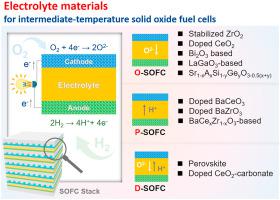当前位置:
X-MOL 学术
›
Prog. Nat. Sci. Mater. Int.
›
论文详情
Our official English website, www.x-mol.net, welcomes your
feedback! (Note: you will need to create a separate account there.)
Electrolyte materials for intermediate-temperature solid oxide fuel cells
Progress in Natural Science: Materials International ( IF 4.8 ) Pub Date : 2020-12-01 , DOI: 10.1016/j.pnsc.2020.09.003 Huangang Shi , Chao Su , Ran Ran , Jiafeng Cao , Zongping Shao
Progress in Natural Science: Materials International ( IF 4.8 ) Pub Date : 2020-12-01 , DOI: 10.1016/j.pnsc.2020.09.003 Huangang Shi , Chao Su , Ran Ran , Jiafeng Cao , Zongping Shao

|
Abstract Solid oxide fuel cells (SOFCs) directly convert chemical energy that is stored in a wide range of fuels into direct current electricity, with high efficiency and low emissions, via a series of electrochemical reactions at elevated operating temperatures (generally 400–1000 °C). During such an energy conversion process, the properties of electrolyte materials determine the working principle and operating temperature of the SOFC. When considering the cost and stability, lowering the operating temperature is critical, and this has become one of the developing trends in SOFC research. The key point for realizing a reduction in operating temperature is to maintain low ohmic resistance of the electrolyte and low polarization resistance of the electrodes. In practice, the mechanical and chemical stability of the electrolyte is also a big concern. According to their differences in ion conduction mechanisms, there are three main types of electrolyte material available, namely, oxygen ion-conducting, proton-conducting, and dual ion-conducting electrolytes. In this review, we give a comprehensive summary of the recent advances in the development of these three types of electrolyte material for intermediate-temperature SOFCs. Both conductivity and stability are emphasized. In conclusion, the current challenges and future development prospects are discussed.
中文翻译:

中温固体氧化物燃料电池用电解质材料
摘要 固体氧化物燃料电池(SOFCs)通过在升高的工作温度(通常为 400-1000 °C)下进行一系列电化学反应,将储存在各种燃料中的化学能直接转化为直流电,具有高效率和低排放的特点。 )。在这样的能量转换过程中,电解质材料的特性决定了 SOFC 的工作原理和工作温度。在考虑成本和稳定性时,降低工作温度至关重要,这已成为 SOFC 研究的发展趋势之一。实现工作温度降低的关键是保持电解液的低欧姆电阻和电极的低极化电阻。在实践中,电解质的机械和化学稳定性也是一个大问题。根据它们在离子传导机制上的差异,可用的电解质材料主要有三种类型,即氧离子传导电解质、质子传导电解质和双离子传导电解质。在这篇综述中,我们全面总结了这三种中温 SOFC 电解质材料的最新进展。强调导电性和稳定性。最后,讨论了当前的挑战和未来的发展前景。我们全面总结了这三种中温SOFCs电解质材料的最新进展。强调导电性和稳定性。最后,讨论了当前的挑战和未来的发展前景。我们全面总结了这三种中温SOFCs电解质材料的最新进展。强调导电性和稳定性。最后,讨论了当前的挑战和未来的发展前景。
更新日期:2020-12-01
中文翻译:

中温固体氧化物燃料电池用电解质材料
摘要 固体氧化物燃料电池(SOFCs)通过在升高的工作温度(通常为 400-1000 °C)下进行一系列电化学反应,将储存在各种燃料中的化学能直接转化为直流电,具有高效率和低排放的特点。 )。在这样的能量转换过程中,电解质材料的特性决定了 SOFC 的工作原理和工作温度。在考虑成本和稳定性时,降低工作温度至关重要,这已成为 SOFC 研究的发展趋势之一。实现工作温度降低的关键是保持电解液的低欧姆电阻和电极的低极化电阻。在实践中,电解质的机械和化学稳定性也是一个大问题。根据它们在离子传导机制上的差异,可用的电解质材料主要有三种类型,即氧离子传导电解质、质子传导电解质和双离子传导电解质。在这篇综述中,我们全面总结了这三种中温 SOFC 电解质材料的最新进展。强调导电性和稳定性。最后,讨论了当前的挑战和未来的发展前景。我们全面总结了这三种中温SOFCs电解质材料的最新进展。强调导电性和稳定性。最后,讨论了当前的挑战和未来的发展前景。我们全面总结了这三种中温SOFCs电解质材料的最新进展。强调导电性和稳定性。最后,讨论了当前的挑战和未来的发展前景。











































 京公网安备 11010802027423号
京公网安备 11010802027423号